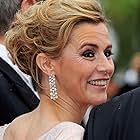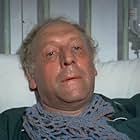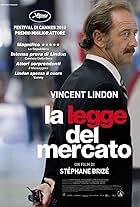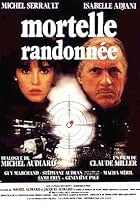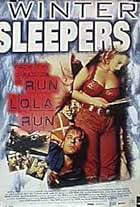Je ne suis pas là pour être aimé
- 2005
- 1h 33min
VALUTAZIONE IMDb
7,1/10
1732
LA TUA VALUTAZIONE
Aggiungi una trama nella tua linguaThe (love) life of a man fed up with his work and life routine changes when he enlists into a tango dancing course.The (love) life of a man fed up with his work and life routine changes when he enlists into a tango dancing course.The (love) life of a man fed up with his work and life routine changes when he enlists into a tango dancing course.
- Premi
- 2 vittorie e 5 candidature
Foto
Marie-Sohna Condé
- Rose Diakité
- (as Marie-Sonha Condé)
Trama
Lo sapevi?
- QuizDedicated to Rose and Ferdinand.
Recensione in evidenza
I went to see this movie because it was advertised as having Argentine tango in it. I am a tango dancer and I was completely blown away by it. But even so let me emphasize that this is not only a movie for tango dancers. I spoke to a non-tango dancer right after the showing and she was equally fascinated. But since this was the reason I wanted to see the film, I choose the tango angle to comment on it.
In this movie tango serves as a metaphor for how people communicate and "meet", in the truest sense of the word. But apart from this Argentinian input it is very French in so far as it has all the significant qualities of a typical French flick: long takes, close-ups, much silence, and intense but subtle emotions -- mostly all of the above at the same time. And altogether quite conducive to the tango content, much more so than an American production could have achieved I daresay.
All throughout the 20th century the Tango and France, especially Paris, have formed a lasting, passionate bond, a love affair that feeds both sides and still prospers. Tango is everywhere in Paris. It's as much part of the upper middle class culture as going to vernissages is. It is useful to know this, otherwise one could wonder how the main protagonist Jean-Claude Delsart, a middle-aged, very reclusive marshal, could so easily end up on the floor of the tango studio across the street from his office.
The way Argentine tango is portrayed in this movie is gracefully true to the soul of tango. It has only one "flashy" scene, a performance by a professional tango couple and as usual with public tango performances, I find this one of its weakest moments: pure form and posture, completely void of feelings and emotions.
But the important scenes in the studio do capture aptly what is so fascinating and endearing about (the mastering of) this dance: the carefulness and timidity in a beginner's approach toward his or her partner's body; the subtlety; the listening; the addictiveness of the intimate atmosphere; the beautiful, beautiful music; the gradually growing confidence and freedom; and
Tango can, at times, have a quite positive and joyful air about it. But its origins have much more in common with what the Portuguese call "fado". A melancholic mood, full of heartache and longing, with the heaviness of reality weighing down on minds and souls that are capable of enduring deep sorrow and intense passion.
This is what the movie is about. "Je ne suis pas là pour être aimé" could be translated as "I do not exist to be loved". A stark, even cruel normative statement that is the point of departure for Delsart. The rest is a journey and, no, I will not tell where it ends. The story as it evolves is sometimes almost unbearably sad and yet the protagonists keep on living through it. The dance isn't over until the last note is played.
The tango metaphor works extremely well with this story and does so until the end. Compared to other "tango movies", this is one of the better ones. Of course, nothing beats Sally Potter's "The Tango Lesson" - but what could.
The only reason I don't give this movie full marks is the fact that some of the plot turns are a bit too predictable. But nevertheless, this is an engaging story well told, well made, with extraordinary characters. A modern fairy tale -- or maybe not?
In this movie tango serves as a metaphor for how people communicate and "meet", in the truest sense of the word. But apart from this Argentinian input it is very French in so far as it has all the significant qualities of a typical French flick: long takes, close-ups, much silence, and intense but subtle emotions -- mostly all of the above at the same time. And altogether quite conducive to the tango content, much more so than an American production could have achieved I daresay.
All throughout the 20th century the Tango and France, especially Paris, have formed a lasting, passionate bond, a love affair that feeds both sides and still prospers. Tango is everywhere in Paris. It's as much part of the upper middle class culture as going to vernissages is. It is useful to know this, otherwise one could wonder how the main protagonist Jean-Claude Delsart, a middle-aged, very reclusive marshal, could so easily end up on the floor of the tango studio across the street from his office.
The way Argentine tango is portrayed in this movie is gracefully true to the soul of tango. It has only one "flashy" scene, a performance by a professional tango couple and as usual with public tango performances, I find this one of its weakest moments: pure form and posture, completely void of feelings and emotions.
But the important scenes in the studio do capture aptly what is so fascinating and endearing about (the mastering of) this dance: the carefulness and timidity in a beginner's approach toward his or her partner's body; the subtlety; the listening; the addictiveness of the intimate atmosphere; the beautiful, beautiful music; the gradually growing confidence and freedom; and
- sometimes, eventually - the passion.
Tango can, at times, have a quite positive and joyful air about it. But its origins have much more in common with what the Portuguese call "fado". A melancholic mood, full of heartache and longing, with the heaviness of reality weighing down on minds and souls that are capable of enduring deep sorrow and intense passion.
This is what the movie is about. "Je ne suis pas là pour être aimé" could be translated as "I do not exist to be loved". A stark, even cruel normative statement that is the point of departure for Delsart. The rest is a journey and, no, I will not tell where it ends. The story as it evolves is sometimes almost unbearably sad and yet the protagonists keep on living through it. The dance isn't over until the last note is played.
The tango metaphor works extremely well with this story and does so until the end. Compared to other "tango movies", this is one of the better ones. Of course, nothing beats Sally Potter's "The Tango Lesson" - but what could.
The only reason I don't give this movie full marks is the fact that some of the plot turns are a bit too predictable. But nevertheless, this is an engaging story well told, well made, with extraordinary characters. A modern fairy tale -- or maybe not?
I più visti
Accedi per valutare e creare un elenco di titoli salvati per ottenere consigli personalizzati
Dettagli
- Data di uscita
- Paese di origine
- Siti ufficiali
- Lingua
- Celebre anche come
- Not Here to Be Loved
- Luoghi delle riprese
- Aziende produttrici
- Vedi altri crediti dell’azienda su IMDbPro
Botteghino
- Lordo in tutto il mondo
- 1.962.402 USD
Contribuisci a questa pagina
Suggerisci una modifica o aggiungi i contenuti mancanti

Divario superiore
By what name was Je ne suis pas là pour être aimé (2005) officially released in India in English?
Rispondi




